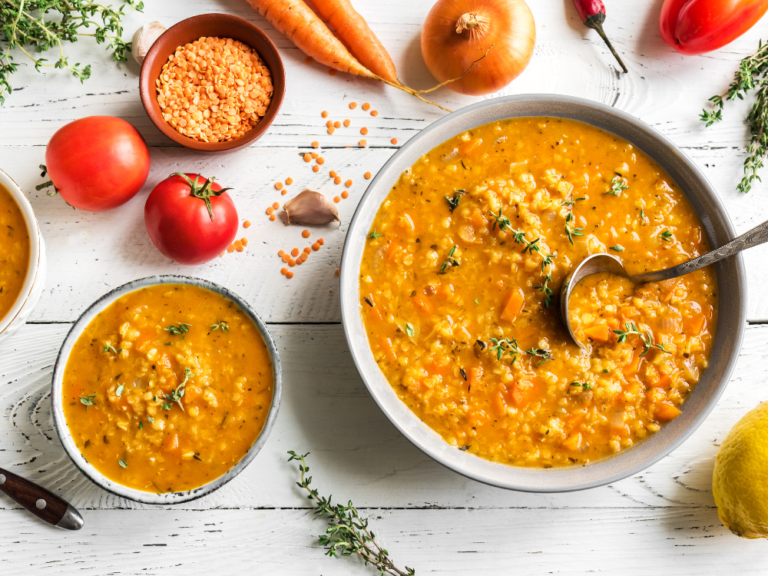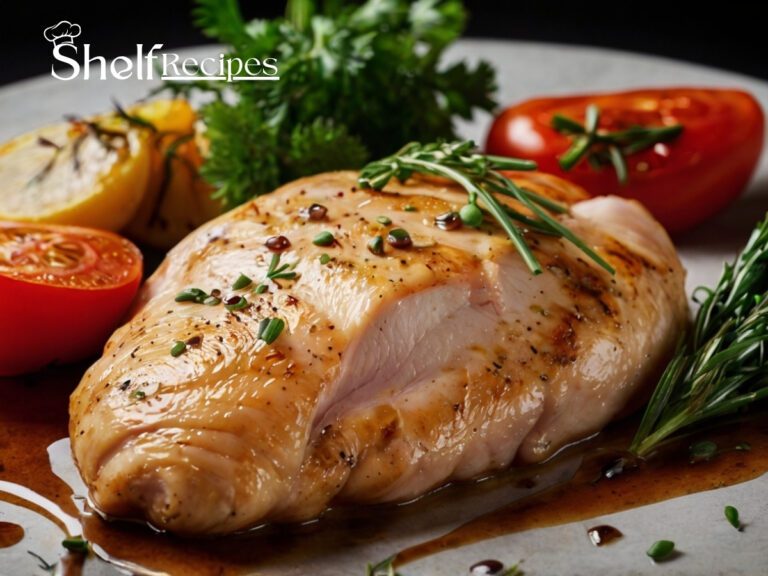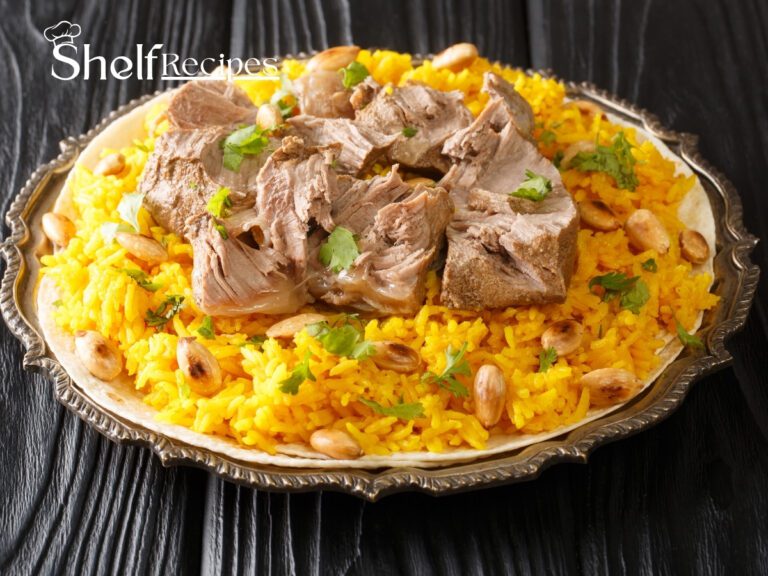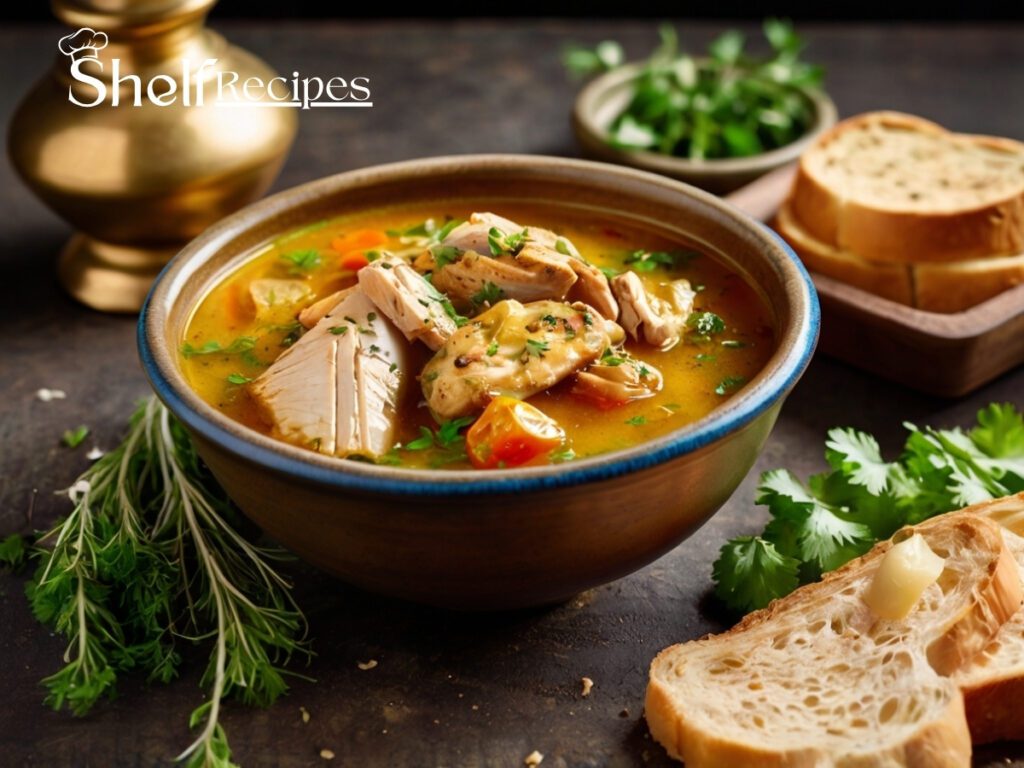
Tashreeb is a beloved dish in Kuwait, known for its rich broth-soaked bread and aromatic spices. This hearty meal is a staple of Kuwaiti cuisine, offering a comforting blend of flavors and textures. Unlike its Iraqi counterpart, Kuwaiti Tashreeb is often made with chicken, infused with Gulf-style spices, and includes vegetables like potatoes and zucchini. Whether enjoyed during Ramadan or as a warming dish in colder months, Tashreeb is a must-try for those who appreciate authentic Middle Eastern flavors.
What is Tashreeb?
Tashreeb is a beloved Arabian dish celebrated across the Gulf, featuring layers of bread soaked in a fragrant, spiced broth. Its name derives from the Arabic “Sharaba” (to drink), highlighting how the bread eagerly drinks up the rich, savory liquid. While variations exist throughout the region, Kuwait’s take often favors chicken over lamb, creating a lighter yet deeply satisfying version that’s a cherished comfort food in Kuwaiti homes and beyond.
Historical Background of Tashreeb
Origins and Evolution:
- Ancient Beginnings:
- Tashreeb traces its roots to the Arabian Peninsula’s nomadic tribes, where resourceful Bedouins used stale bread and leftover meat broth to create a hearty, no-waste meal suited to desert life.
- Culinary Adaptation:
- Over centuries, as trade routes flourished across the Gulf, Tashreeb absorbed influences from Persia and India, incorporating spices like turmeric, cinnamon, and cardamom into its flavorful broth.
- Regional Spread:
- By the medieval era, this dish had spread across Iraq, Kuwait, Qatar, and beyond, each region tweaking it—Kuwait favoring chicken, while Iraq often opts for lamb or beef.
Significance in Arabian Culture:
- Communal Tradition:
- Tashreeb evolved into a symbol of hospitality, served in large trays for families and guests, reflecting the Gulf’s emphasis on generosity and togetherness.
- Ramadan Staple:
- Its nourishing broth and filling bread made it a Ramadan favorite by the 20th century, offering comfort and sustenance after a day of fasting across the region.
- Pre-Oil Sustenance:
- Before the Gulf’s oil wealth, Tashreeb was a dietary mainstay, stretching simple ingredients into a satisfying dish that sustained fishing and trading communities.
Historical Practices and Modern Legacy:
- Traditional Methods:
- Originally cooked over open fires with flatbreads like regag or khubz soaking up slow-simmered broths, Tashreeb’s preparation was a labor of love and practicality.
- Cultural Icon:
- As Gulf nations modernized, Tashreeb retained its prominence, with Kuwait’s chicken version gaining fame for its lighter touch, often showcased at national celebrations.
- Global Journey:
- Today, Tashreeb has traveled with Gulf diasporas to Europe and North America, appearing in cookbooks and restaurants, preserving its heritage while adapting to new palates.
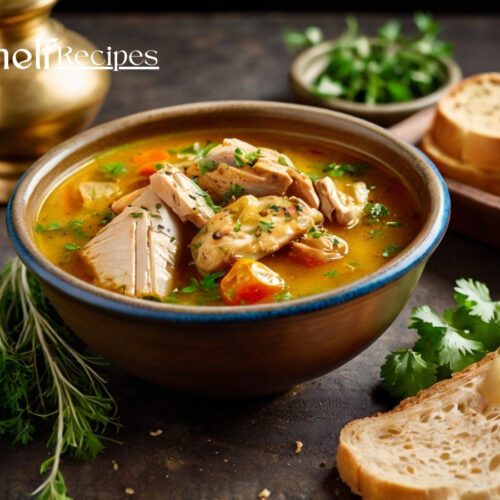
Tashreeb
Ingredients
For the Broth:
- 1 whole chicken cut into pieces
- 2 large onions chopped
- 3 garlic cloves minced
- 2 tomatoes finely chopped
- 2 potatoes peeled and cubed
- 1 zucchini sliced
- 2 tablespoons tomato paste
- 1 teaspoon turmeric
- 1 teaspoon ground cinnamon
- 1 teaspoon black pepper
- 1 teaspoon cumin
- 1 teaspoon cardamom powder
- 1 teaspoon dried lime powder loomi
- 6 cups water
- Salt to taste
- 2 tablespoons vegetable oil
For the Bread Layer:
- 4-5 pieces of Khubz Regag thin Kuwaiti bread or pita bread, torn into large pieces
- Fresh cilantro for garnish optional
Instructions
Step 1: Prepare the Broth
- In a large pot, heat vegetable oil over medium heat. Add the chopped onions and garlic, sautéing until golden brown.
- Add the chicken pieces and cook until lightly browned on all sides.
- Stir in the tomatoes and tomato paste, cooking until softened.
- Add the spices (turmeric, cinnamon, black pepper, cumin, cardamom, loomi, and salt). Stir well to coat the chicken.
- Pour in 6 cups of water and bring the mixture to a boil. Reduce heat and let it simmer for about 40 minutes.
Step 2: Add Vegetables
- Add the cubed potatoes and sliced zucchini to the pot. Continue simmering for another 15 minutes until the vegetables are tender.
Step 3: Assemble the Tashreeb
- In a large serving dish, layer the torn Khubz Regag or pita bread.
- Gently pour the hot broth over the bread, allowing it to soak and soften.
- Arrange the chicken and vegetables on top.
- Garnish with fresh cilantro, if desired.
Equipment Needed for Kuwaiti Tashreeb
To prepare Kuwaiti Tashreeb efficiently, you’ll need the following kitchen tools:
- Large pot – For cooking the broth and chicken.
- Cutting board – To chop vegetables and prepare ingredients.
- Sharp knife – For slicing and dicing vegetables, chicken, and bread.
- Wooden spoon or spatula – For stirring the broth and ingredients.
- Measuring spoons & cups – To ensure the correct amount of spices and liquids.
- Serving dish – To layer the bread and assemble the final dish.
- Ladle – For pouring the broth over the bread.
Tips for the Perfect Tashreeb
- Choose the Right Bread: Use sturdy flatbreads like khubz or regag that hold up well when soaked—slightly stale bread works best to absorb broth without falling apart.
- Layer Thoughtfully: Arrange bread in a deep dish and ladle hot broth evenly over it to ensure every bite is infused with flavor—don’t drown it too soon to keep some texture.
- Simmer Low and Slow: Cook the broth (chicken, lamb, or veggie) gently for at least an hour to deepen the spices—skim foam for a clear, rich taste.
- Season Boldly: Add Kuwaiti staples like baharat spice mix or dried limes (loomi) for authentic depth, adjusting salt and pepper just before serving.
- Serve Hot: Present Tashreeb steaming fresh from the pot, topped with tender meat or herbs, so the warmth and aroma shine through every spoonful.
Nutritional Benefits of Tashreeb
Hearty Nourishment:
- Protein Power:
- Chicken (common in Kuwait) or lamb provides high-quality protein for muscle repair and energy, making Tashreeb a filling post-fast meal.
- Carb Comfort:
- The bread offers complex carbs for sustained energy, soaking up broth to create a satisfying base that fuels long days or Ramadan nights.
- Hydration Boost:
- The rich broth aids rehydration, delivering electrolytes like sodium and potassium—vital in the Gulf’s hot climate or after fasting.
- Vitamin Rich:
- Veggies often added (like tomatoes or onions) bring vitamins C and A, while spices like turmeric offer antioxidants for immunity and inflammation control.
- Bone Strength:
- If made with bone-in meat, Tashreeb extracts collagen and minerals like calcium, supporting joints and bones with every savory sip.
- Fiber Support:
- Whole-grain bread and optional legumes (like chickpeas in some versions) add fiber, aiding digestion and fullness—a bonus for balanced eating.
- Healthy Fats:
- A drizzle of olive oil or ghee (sometimes used) provides heart-friendly fats, enhancing flavor while supporting brain health in moderation.
- Metabolism Kick:
- Spices like black pepper or chili (if included) boost metabolism and circulation, adding a subtle health perk to the dish’s warmth.
- Mood Lift:
- The comforting combo of broth and bread supports serotonin production, offering a gentle emotional uplift during shared meals.
- Customizable Nutrition:
- Lighter Kuwaiti chicken versions cut fat, while veggie broth options increase vitamins—tailoring Tashreeb to diverse dietary needs.
What to Serve with Kuwaiti Tashreeb
Kuwaiti Tashreeb shines even brighter with thoughtful sides that complement its hearty, spiced goodness:
- Fresh Salad: Pair with a crisp cucumber, tomato, and parsley salad drizzled with lemon and olive oil—its freshness cuts through the richness and adds a vibrant crunch.
- Yogurt: Serve a bowl of cool, plain yogurt (or with a hint of garlic and mint) as a creamy, soothing contrast to the warm, bold spices in the broth.
- Pickles: Offer tangy pickled turnips, cucumbers, or spicy green chilies for a zesty kick that lifts the dish’s flavors and adds a playful bite.
- Dates: A few sweet Kuwaiti dates on the side nod to Gulf tradition, balancing savory with a touch of natural sweetness.
- Herb Garnish: Sprinkle fresh dill or cilantro over the Tashreeb itself for a burst of color and an aromatic finish that ties it all together.
Why You Should Try Kuwaiti Tashreeb
- Authentic Kuwaiti Flavor:
- Infused with Gulf-style spices like baharat and dried limes (loomi), this dish delivers a distinctive, soul-warming taste straight from Kuwait’s culinary heart.
- Comforting & Satisfying:
- The tender, broth-soaked bread melded with rich, spiced chicken broth wraps you in cozy comfort, making it a go-to for chilly nights or post-fast relief.
- Nutritious & Balanced:
- Loaded with protein from chicken, fiber from bread, and healthy carbs, it’s a well-rounded meal that fuels you without weighing you down—a Kuwaiti classic with purpose.
- Cultural Connection:
- Every bite of Tashreeb offers a taste of Kuwait’s heritage, blending Bedouin simplicity with the Gulf’s love for bold, communal dishes—a true food story.
- Easy to Love:
- Its familiar yet exotic appeal—think spiced soup meets savory bread pudding—makes it a dish that’s both approachable and unforgettable for any food lover.
Serving Suggestions & Variations for Kuwaiti Tashreeb
Classic Serving:
- Warm Bread Base: Serve over torn pieces of khubz or regag bread, letting the broth soak in for a soft, flavorful bite—perfect with a sprinkle of fresh parsley.
- Side of Daqoos: Pair with Kuwaiti daqoos (a spicy tomato-garlic sauce) to drizzle on top, adding a tangy, zesty contrast to the rich stew.
Flavor Enhancements:
- Citrus Twist: Squeeze fresh lemon over the dish just before eating to brighten the spices and cut through the richness.
- Nutty Crunch: Garnish with toasted pine nuts or slivered almonds for a subtle crunch and a touch of elegance, common in Gulf feasts.
Creative Variations:
- Seafood Swap: Replace chicken with fish or shrimp for a coastal Kuwaiti twist, reflecting the Gulf’s seafood heritage—simmer with dill for extra flavor.
- Veggie Boost: Add chickpeas or lentils alongside the veggies for a heartier, protein-packed version that’s still light and nutritious.
- Spicy Kick: Stir in a spoonful of harissa or crushed red chilies to the broth for a fiery edge that warms you from the inside out.
FAQ About Kuwaiti Tashreeb
What’s the best bread for Tashreeb?
- Sturdy flatbreads like khubz or regag are ideal—they soak up broth without disintegrating. Slightly stale bread works even better for texture.
Can I make Tashreeb ahead of time?
- Yes! Prepare the broth and meat in advance, then reheat and pour over fresh bread when ready to serve to keep it from getting too soggy.
Is Tashreeb always made with chicken in Kuwait?
- No, while chicken is popular in Kuwait for a lighter dish, lamb or beef versions are also common across the Gulf, offering a richer taste.
How can I make it vegetarian?
- Skip the meat and use veggie broth with hearty additions like eggplant, zucchini, and chickpeas—season generously with baharat for depth.
Why is it a Ramadan favorite?
- Its warm, broth-soaked bread and protein make it filling yet easy to digest, perfect for breaking the fast with comfort and nutrition.
More Kuwaiti Recipes to Try
If you love Kuwaiti cuisine, explore these delicious dishes:
- Daqoos from Global Table Adventure – A spicy, garlicky tomato sauce that adds a zesty kick to rice dishes or Tashreeb, a Gulf staple with bold flavor.
- Madrouba by The Odehlicious – A creamy porridge of mashed fish or meat with rice or wheat, seasoned with warm spices for a comforting meal.
Final Thoughts
Tashreeb is more than just a meal; it’s a cultural experience that brings families together around the dinner table. Whether you’re trying Kuwaiti cuisine for the first time or looking for a new Middle Eastern dish to add to your recipe collection, Kuwaiti Tashreeb is a must-try.
Have you ever tried Tashreeb before? Let us know in the comments below!
Don’t forget to check out more on our Ramadan recipes page from different countries!
